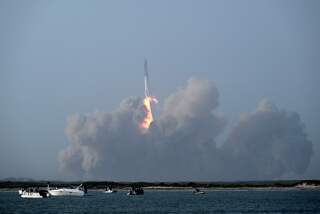SpaceX will soon launch and land its giant Mars spaceship. But its other 2019 goals are more down-to-earth
SpaceX’s long-stated plans to reach the Red Planet could take a big step forward as early as February with a so-called “hopper test” of the company’s Mars spaceship prototype.
During next month’s test, the prototype will launch and briefly go up in the air before coming back down to Earth, Chief Executive Elon Musk revealed last week. But in line with typical Musk timelines, he gave himself a buffer, tweeting Saturday that four weeks “probably means eight weeks, due to unforeseen issues.”
Formerly known as BFR, the test spaceship is being assembled in south Texas, about 23 miles east of Brownsville. The vehicle is now called Starship and is intended to launch on top of a massive rocket booster called Super Heavy. The company plans to build the Super Heavy booster and production versions of the Starship at a 19-acre site at the Port of Los Angeles.
Musk has not been shy about the company’s goal of making humans into a multi-planetary species to protect against any potential extinction on Earth. But SpaceX’s current revenue streams are decidedly more terrestrial in nature — satellite launches for commercial and government customers and supply runs for NASA to the International Space Station.
Starship would be a play for a completely different market — planetary exploration — that is now dominated only by government. And demand for a potential commercial market is still “highly uncertain,” said Carissa Christensen, chief executive of consulting firm Bryce Space and Technology.
“We’re still in the speculative stage, partly because the costs are very high,” she said.
Musk has estimated that development of Starship and the Super Heavy booster could cost about $5 billion.
Finding a balance between existing and future markets is part of the growth equation for any maturing company, Christensen said. When he unveiled the first commercial passenger for the then-named BFR, for a trip around the moon, Musk posited that space tourism could become a big source of funding for the vehicle.
But positioning for new opportunities can be risky, both technically and financially, Christensen said.
“The cost of over-investing can be very high, and the cost of under-investing can eventually be very high,” she said.
Starship’s planned hopper test is similar to those SpaceX conducted from 2012 to 2014 with its Grasshopper and F9R test rockets, precursors to its workhorse Falcon 9 rocket.
Pictures in the News | Wednesday Jan. 9, 2019 »
The 10-story Grasshopper rocket, which was basically a Falcon 9 first-stage booster with one engine and landing legs, completed eight test flights and landings at the company’s McGregor, Texas, facility. After Grasshopper, the Hawthorne company tested the F9R (Falcon 9 Reusable) test vehicle, which had three engines and went as high as 3,200 feet in the air before landing back on Earth.
SpaceX has so far successfully landed its first-stage Falcon 9 booster 32 times, either at sea or on the ground.

In the last few weeks, Musk has relied on his favorite medium to release more details about Starship’s development. In late December, Musk tweeted Starship would have a “stainless mirror finish” because the spaceship’s skin would “get too hot for paint.” Later that day, he said the spaceship would “look like liquid silver” because a side would be cooled with cryogenic liquid methane.
Then on Saturday, Musk tweeted an illustration of a bullet-shaped stainless-steel spaceship, saying the Starship test vehicle would look similar when finished, though it would “obv[iously] have windows.”
Starship is intended to carry as many as 100 passengers to the moon and Mars. In September, the company announced that Japanese e-commerce billionaire Yusaku Maezawa would be the first paying customer to travel around the moon on the vehicle. Maezawa has said his flight will occur in 2023.
Musk said the first hopper engine to be fired was “almost finished assembly in California” and predicted it would “probably” have a test fire next month. The engines currently on the prototype are a mix of operational parts and “Raptor development” — the liquid-methane-fueled rocket engine that will power the vehicle.
While Starship is likely the top priority for project development, SpaceX’s No. 1 operational task is launching NASA astronauts to the space station in its Crew Dragon capsule, said John Logsdon, professor emeritus at the Space Policy Institute at George Washington University. That NASA commercial crew contract — worth up to $2.6 billion to SpaceX — will mark the first time NASA astronauts have taken off from U.S. soil since the space shuttle program ended in 2011, and it could have implications for future Starship development.
“The kind of focus on engineering excellence that’s essential to meet the crew safety standards for commercial crew is the same kind of intense focus on quality that is required to make something as ambitious as Starship successful,” he said.
Twitter: @smasunaga
More to Read
Inside the business of entertainment
The Wide Shot brings you news, analysis and insights on everything from streaming wars to production — and what it all means for the future.
You may occasionally receive promotional content from the Los Angeles Times.











